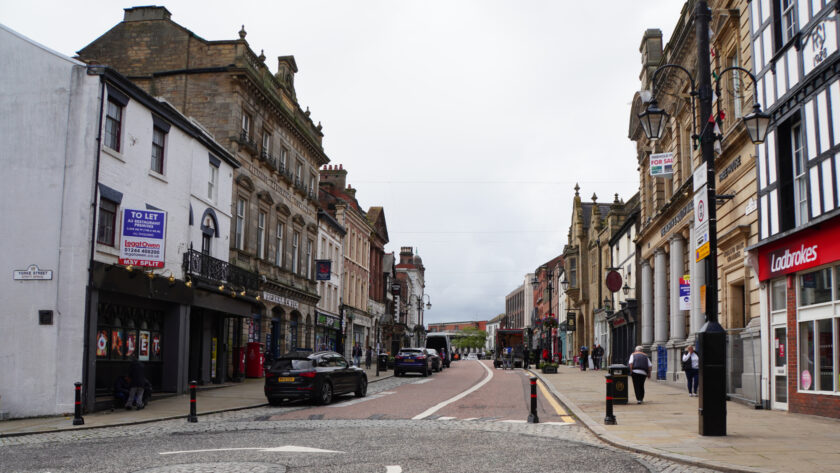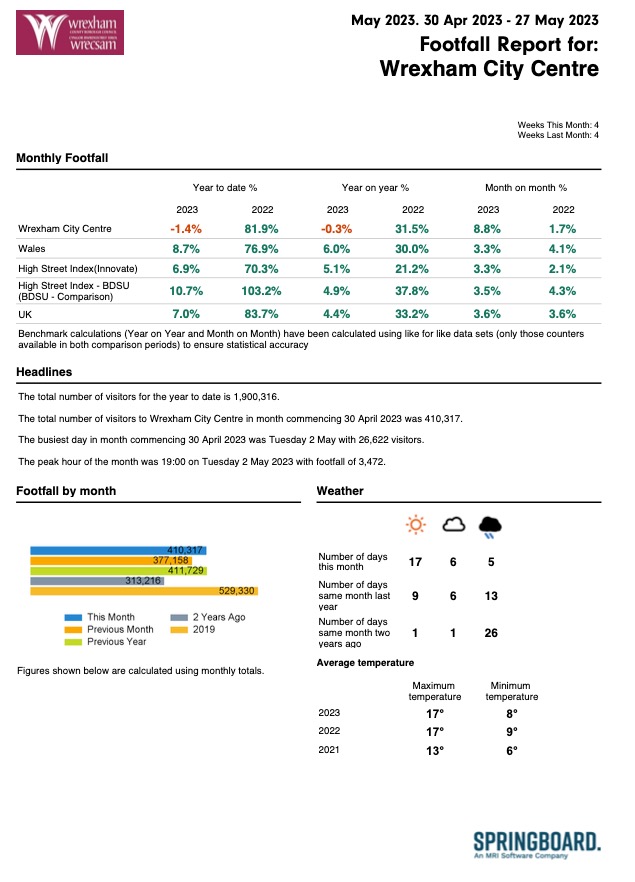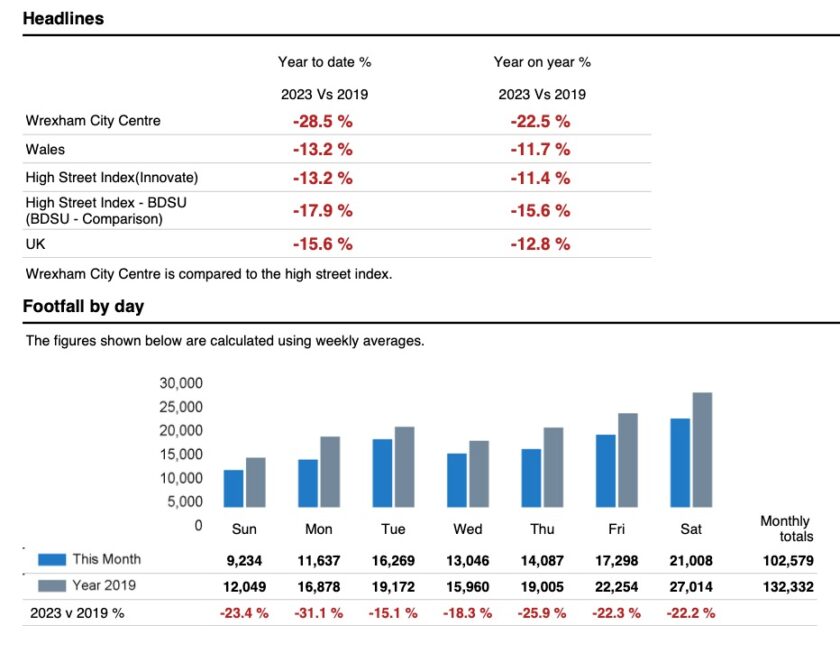Wrexham’s footfall has not yet returned to the pre-pandemic levels of 2019 as Springboard publish Wales-wide view

A footfall data company used in Wrexham has reported Wales’s footfall has dropped for only the second time since 2009 – attributed to “ever rising interest rates, rain and ongoing rail disruption – a dampening of consumer demand that is set to continue into August and September”.
Wrexham Council have said a ‘deeper look’ at the city’s footfall data will take place next month with report to councillors going before Scrutiny.
The Council have shared some ‘initial analysis’ that they say suggests the following:
- Footfall has not yet returned to the pre-Covid levels of 2019. This is not a huge surprise due to changes in working patterns, shopping habits etc.
- However, we have seen a re-establishment of the same seasonal pattern of footfall, with the 2022 figures plotting a very similar shape as that seen in 2019, peaking at the same points and falling at the same points (in broad terms). The pattern in 2023 is again similar, although overall numbers are slightly down compared to last year (more info in next bullet point)
- When comparing 2023 with last year, it looks like the early part of 2023 saw an increase compared to the same point in 2022, but by July we were slightly behind. This year to date there have been 2,757,569 people counted, compared to 2,834,214 in 2022.
- The data does seem to suggest that we’re seeing lower numbers recorded on Fridays and Saturdays and particularly after 7pm.
- In terms of ‘wet days’, the data suggests this year July was drier than in 2022 (although we know that’s at odds with the lived experience – July this year was incredibly wet!), and weather does have an impact on consumer choices.
- The current financial climate could also mean people have less disposable income – which could be a factor?
Councillor Nigel Williams, Wrexham Council’s Lead Member for Economy, said: “Like most towns and cities, Wrexham is still establishing a new ‘normal’ following the Covid pandemic. There are still many variables and it’s likely that shopping and leisure patterns will continue to change.
“The weather and the economy will always be a factor, and climate change, economic uncertainty and cost of living pressures do make it more difficult to predict the future, but this data is invaluable and we have a lot to feel positive about in Wrexham.
“There is a strong programme of events, new shops and businesses are opening, and projects such as the indoor markets renovation, museum redevelopment and Placemaking Plan that will further enhance the offer and bring people into the city centre.
“We’ll continue to monitor footfall trends and will make the most of opportunities like the Welsh Government Transforming Towns initiative, tourism and Wrexham’s increased global profile to enhance the offer in our city.”
Wrexham use ‘Springboard’ who record footfall and other data to then create useful reports that include weekly footfall, insights, weekly sales data, weather, average temperatures, maximum temperatures, a rolling 13 week view, percentage week on week / year on year changes, and footfall by location.
Springboard have recently published figures for the whole of Wales for the four weeks 2nd July 2023 – 29th July 2023, and they observe:
- Footfall across Wales’s retail destinations declined by -3.3% over the month from June to July 2023, versus a rise of +7.3% over the month from May to June 2023.
- This is only the second July since MRI Springboard started publishing its data in 2009 that footfall was lower than in June.
- There was a month on month decrease in footfall in high streets of -7.2% and -0.3% in retail parks and a month on month increase of +1.8% in shopping centres.
- Footfall rose annually by +3.3% in June across all Wales’s retail destinations (versus +6.9% in June); by +1.2% in high streets, by +9.6% in shopping centres and by +1.3% in retail parks.
- The gap from Wales’s pre-pandemic footfall level widened to -14.5% in July from -9.8% in June; in high streets the gap widened to -15.2% from -5.4% in June and in retail parks to -4.6% from -4.5% in June, whilst in shopping centres the gap narrowed marginally from -23.9% to -22.4% in June.
Springboard’s analysis said, “July appeared to demonstrate the harsh reality of the impact of interest rate rises on consumers, combined with rain and a rail overtime ban on several days in the month. This meant that footfall across Wales’s retail destinations was -3.3% lower than June
2023, which is only the second July since MRI Springboard started publishing its data in 2009 that footfall was lower than in June (in July 2021 footfall was -1.8% lower than in June 2021 when it had risen by +15.9% from May following the end of Lockdown 3). Indeed, over the decade to 2019 the average month on month rise in footfall from June to July was +2.2%.
“All of the decrease from June emanated from high streets and retail parks, where there was a month on month decrease in footfall of -7.2% and -0.3% respectively. In shopping centres footfall was +1.8% higher than the month before, however, this rise was more subdued than in July in previous years; when it averaged +2.9% since 2009. The greater impact on footfall in high streets is in part likely to be due to the rain, as shoppers tend to gravitate towards either the covered environments of shopping centres or retail parks as they are easier to access by car. There was also likely to be an additional impact on high streets, caused by some employees opting to work from home on the days when rail overtime bans occurred.”
Diane Wehrle, Marketing & Insights Director at Springboard added, “Inevitably suppressed customer activity in July impacted on the uplift from 2022, leading to an annual rise of +3.3% in July versus +6.9% in June. Most of this was felt by high streets where footfall was just +1.2% ahead of July 2022 versus an annual rise of +10.1% in June 2022. In retail parks the annual uplift from 2022 improved to +1.3% from -1.1% in June, and in shopping centres it strengthened slightly to +9.6% from +7.8% in June.
“The gap from the 2019 footfall level widened to -14.5% across all of Wales’s retail destinations, with the most significant effect being felt by high streets where the gap widened to -15.2% in July from -5.4% in June. In shopping centres the gap narrowed marginally from -23.9% in June to -22.4% in July, and in retail parks it widened to -4.6% in July from -4.5% in June.”
“Whilst we have the experience of footfall bouncing back from a negative position in March to a positive one in April, it is not anticipated that this will necessarily be replicated in August this year. The August bank holiday is a less significant public holiday than Easter which is what drove additional footfall in April, and the impact of the increase in interest rates, with the Bank of England set to announce on Thursday further increases, is clearly now starting to be felt.
“With the fourth quarter of the year looming, and many holidays either paid for or taken, it is inevitable that consumers’ attention will now turn towards planning for Christmas spending, which may well dampen footfall further in the latter part of the summer.”
Below is the latest set of footfall figures that were provided to councillors at Employment, Business and Investment Scrutiny Committee on Tuesday 13th June. The full PDF can be found here – it was not part of the public report packs.
Spotted something? Got a story? Email [email protected]














